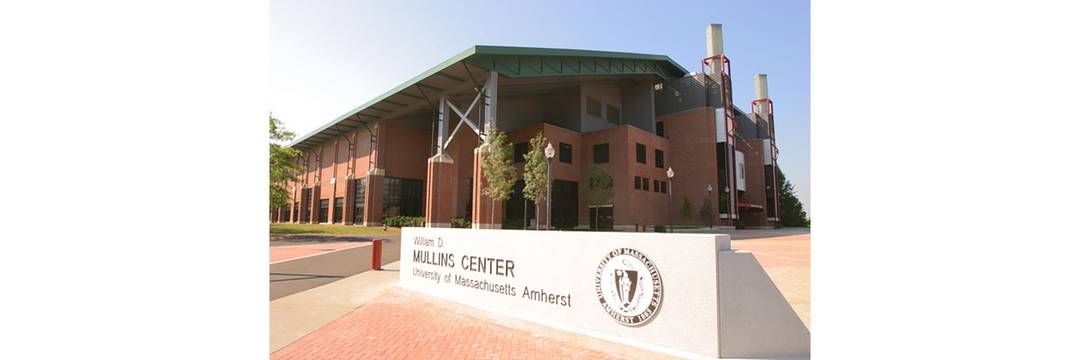
University of Massachusetts Mullins Center Arena mit neuem QSC Beschallungssystem
Includes ILA Installation Line Arrays, PowerLight™ Amplifiers and Q-Sys™ Integrated System Platform
Amherst, MA (Nov 4, 2012) — Located on the campus of the University of Massachusetts, the largest public university in New England, the 10,500-seat William D. Mullins Memorial Center arena unveiled the replacement for its 20-year-old installed PA system in mid-October. The new system includes a QSC Audio ILA System comprising seventy-two WL2082-i line array elements and twelve WL118-sw subwoofers driven by twenty-two PowerLight™ 3 Series PL340 amplifiers, all under the control of two Q-Sys™ Core 250i units with a Q-Sys I/O Frame.
The Mullins Center — which is managed by Global Spectrum, a private venue management firm that oversees more than 100 venues worldwide — is home to UMass Amherst’s Minutemen basketball and ice hockey and Minutewomen basketball teams. The arena also hosts concerts and other events, as well as productions by a variety of UMass departments.
The Mullins Center’s new QSC system was designed by Acentech and installed by North American Theatrix, working with McPhee Electric. According to Scott Jordan, Consultant in Acentech’s Audiovisual Systems Group, he was initially considering a different manufacturer : “We had some initial ideas on which direction we wanted to go with this design, based on the client’s requests. We had another manufacturer’s product in mind that we have used before. However we were limited in the locations available to put new loudspeakers. Getting further into the design, I created a model of the space in EASE (3D modeling/loudspeaker prediction software), and quickly discovered that our initial choice was not going to work. We needed more loudspeakers to obtain the coverage, but even doubling up our initial choice would not give us the coverage we ultimately needed. It would also exceed the given budget for this project by almost double.”
Jordan continues, “ So the hunt was out to find a loudspeaker that would give us the necessary wide vertical coverage required, keep the weight in check, and most importantly fit within our budget. At this point I took a look at the QSC ILA product, having been familiar other QSC products prior. Once the loudspeakers were put in the model in EASE, it was clear these enclosures would do what I needed them to do. The price point on these also allowed us to add those additional enclosures while staying well within our original budget.”
Pat Nelson, Director of Projects, North American Theatrix, also worked up an EASE Focus model, in consultation with QSC Audio, and confirmed Jordan’s findings. Both predictions were right on the money. “Probably the most rewarding part of this project was when we first fired up the QSC system — it sounded amazing right out of the box,” reports Nelson. “There wasn't a whole lot of work that we ended up doing because it just worked as predicted.” And Jordan adds, “Pat grabbed a co-worker and me when we were going in to test the system. He said, ‘You guys have got to hear this!’ It was genuine excitement.”
The ILA System is distributed in eight arrays around the sports arena, three on each side and one in each end zone, as well as three arrays covering the floor “They're flown directly above the first row of seats,” Jordan reports. “The distance down to the first row of seats is about the same as the distance to the last row, so coverage is very consistent throughout the entire facility. ”
As for intelligibility, he says, “It's a concrete hockey rink and we're getting STI [speech transmission index] levels of 0.54 or better -that's considered good to very good, and well within what we expected.” There is no shortage of output, either,” he says. “We achieved 112 dB, and we still had headroom in the system.”
The new system also includes a Yamaha LS932 digital mixing console fitted with CobraNet output cards feeding two Q-Sys Core 250i processors installed 400 feet away in the gridwork high above the floor alongside the PL340 amplifiers. Greg Downing here at NAT was instrumental in doing all of the programming for the system with Q-Sys. “The Q-Sys feeds are sent to the amplifiers through DataPort, so everything is digital all the way to the amps,” says Nelson. “We've used the Q-Sys Core 1000 in other arenas in the past, but this was our first time using rthe Core 250i. We got some of the first units to be produced.”
“We have an I/O Frame down in an existing amp room that's providing a couple of local inputs and outputs” adds Jordan. “There are still some legacy audio systems in place in Mullins for the concourse and other public areas we didn’t change, and it was important to have a DSP system in place that could expand as necessary to allow for those eventual upgrades.”
Nelson concludes, “The client was very happy. The new QSC Loudspeaker system is leaps and bounds ahead of what they had — in 20 years the technology has improved so much. The coverage sounds very even, all the way from the first row of seats to the very upper nosebleed seats. That's a great accomplishment.”